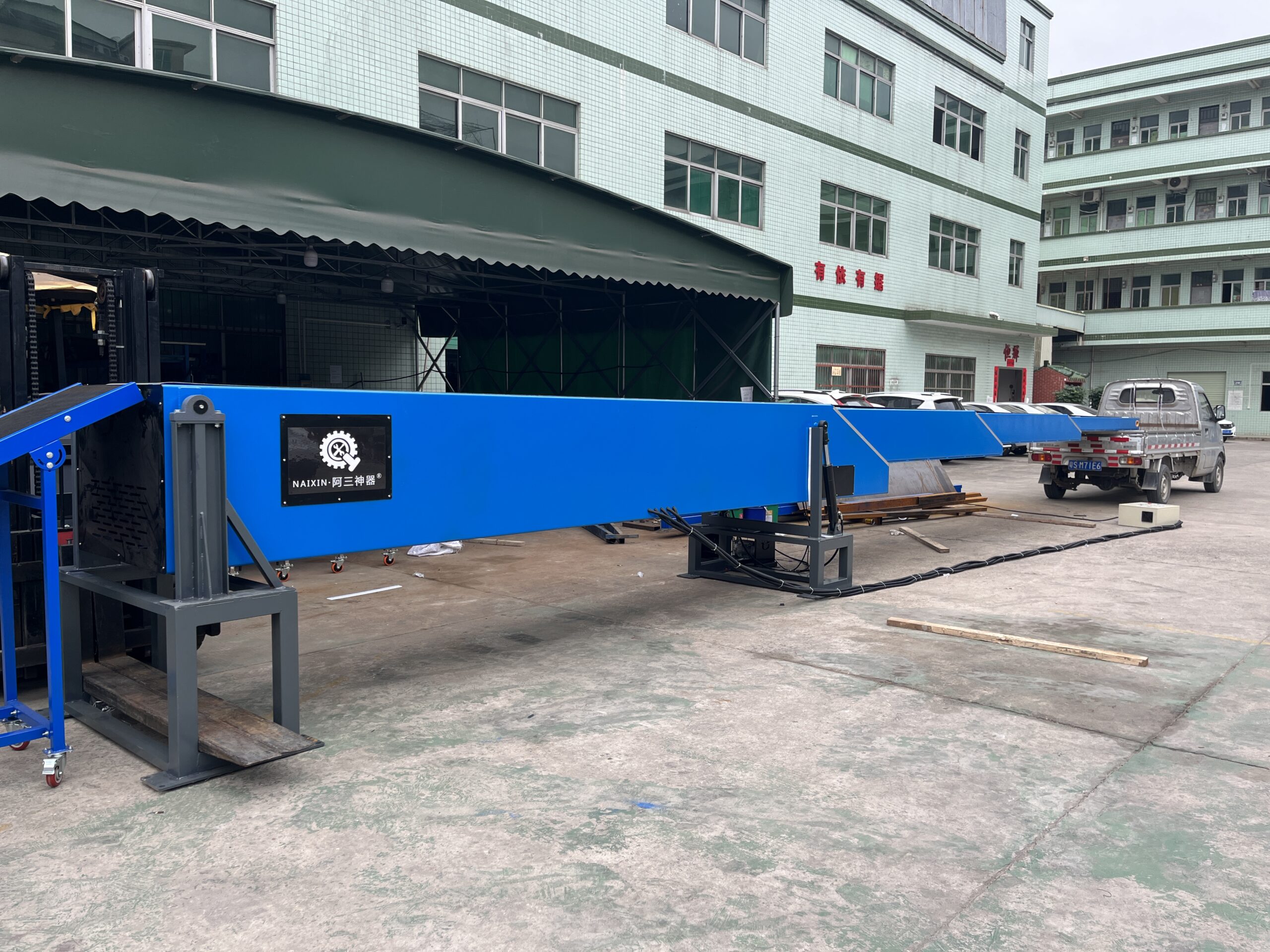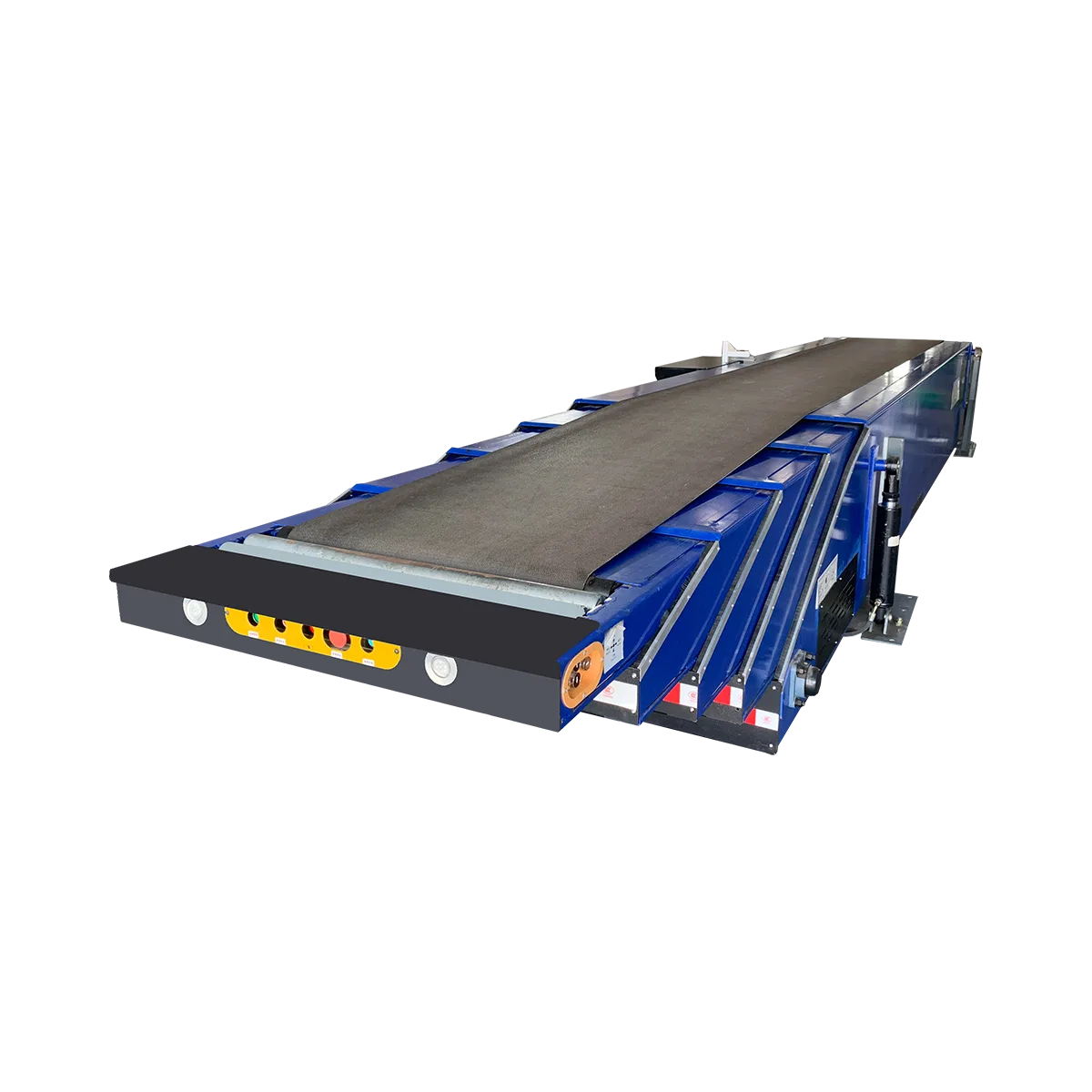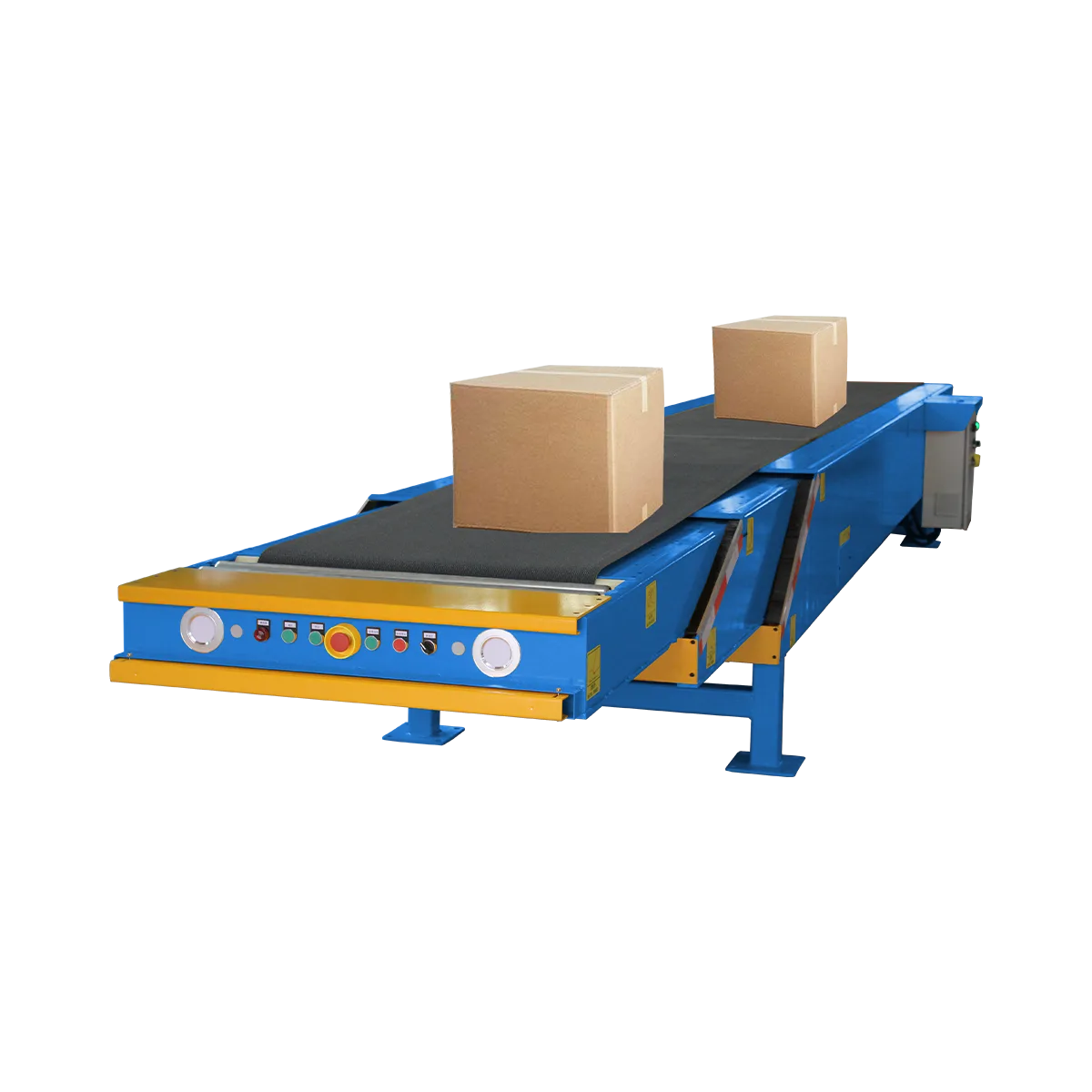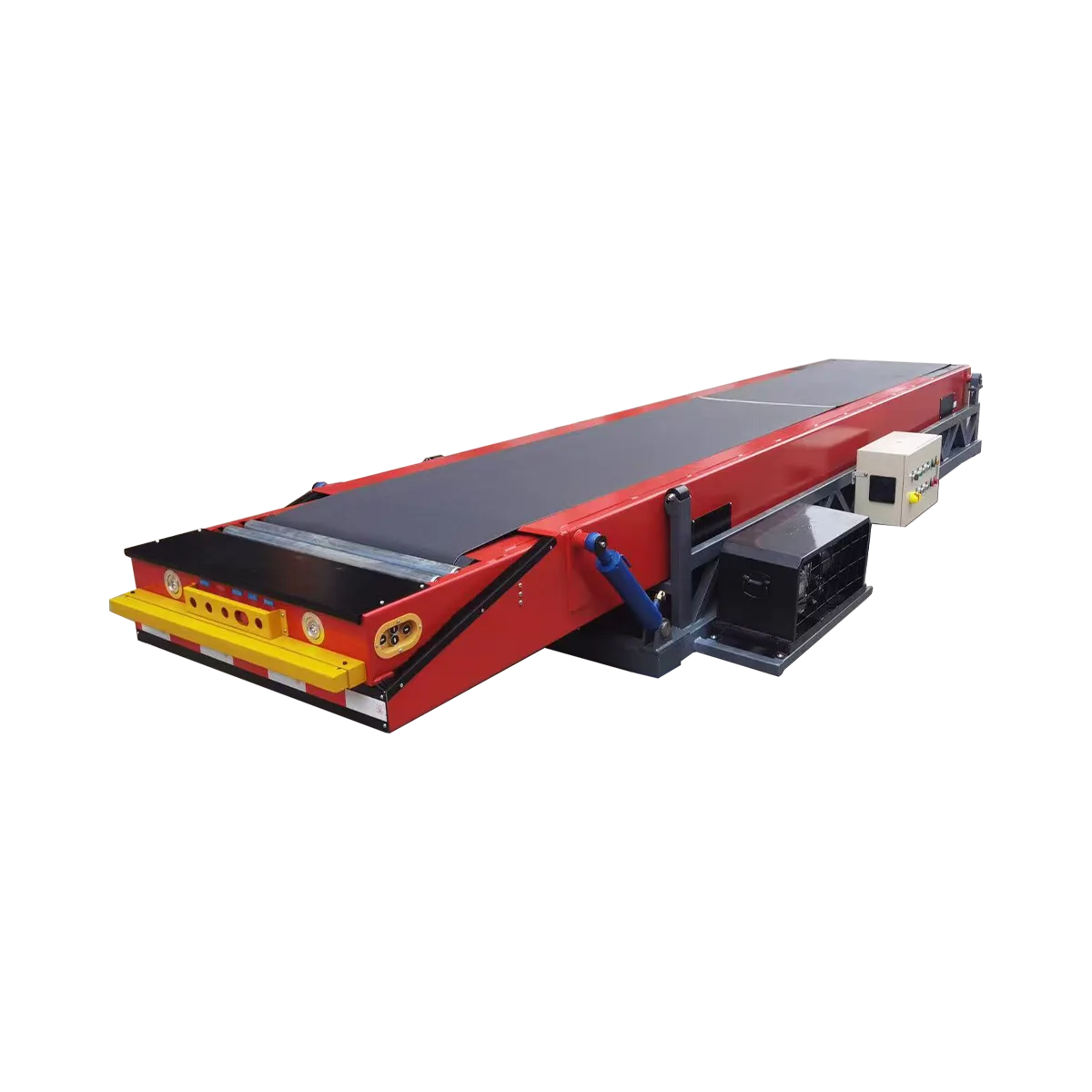What is Telescopic Boom Conveyor?
A telescopic boom conveyor is an advanced material handling system designed to dramatically improve loading and unloading efficiency in warehouses, distribution centers, and logistics facilities.
Related Products
-
TeleScopic Conveyor – 5 SectionsCollapsed Length
6000/7000 mm
Extended Length22000/24000 mm
Load Capacity60 kg/m
Applicable GoodsFlat-bottomed Goods
Bagged Goods
-
TeleScopic Conveyor – 4 SectionsCollapsed Length
5000/6000/7000/8000 mm
Extended Length14000/18000/21000/25000 mm
Load Capacity60 kg/m
Applicable GoodsFlat-bottomed Goods
Bagged Goods
-
TeleScopic Conveyor – 3 SectionsCollapsed Length
4000/5000/6000/6000/7000/7000 mm
Extended Length9000/12000/14000/14500/15000/15500 mm
Load Capacity60 kg/m
Applicable GoodsFlat-bottomed Goods
Bagged Goods
-
TeleScopic Conveyor – 2 SectionsCollapsed Length
3000/4000/5000/6000/7000 mm
Extended Length5000/7000/9000/11000/13000 mm
Load Capacity60 kg/m
Applicable GoodsFlat-bottomed Goods
Bagged Goods
A telescopic boom conveyor is an advanced material handling system designed to dramatically improve loading and unloading efficiency in warehouses, distribution centers, and logistics facilities. This innovative equipment features a multi-section extendable design that can reach deep into containers, trucks, and trailers, effectively eliminating the need for workers to manually enter cargo spaces. Telescopic boom conveyors combine the benefits of extended reach with bidirectional operation, adjustable height, and impressive throughput capabilities, making them essential equipment for modern logistics operations seeking to reduce labor costs, minimize product damage, and accelerate cargo handling processes.

Understanding Telescopic Boom Conveyor Technology
A telescopic boom conveyor utilizes sophisticated engineering to provide exceptional reach and versatility in loading and unloading operations. The system consists of multiple nested sections (typically 2, 3, 4, or 5 sections) that telescope outward, allowing the conveyor to extend from a compact storage position to impressive working lengths.
The core technology centers around a continuous 3mm PVK anti-impact composite belt with steel hook joints that runs along the entire length of the extended conveyor. This design ensures smooth product transportation regardless of the extension level, maintaining consistent performance whether the boom is partially or fully extended.
Key technological features include:
- Extendable reach up to 17 meters (with 5-section models)
- Continuous belt operation across all sections
- Dual motor system for conveyor operation and extension functions
- Variable speed control ranging from 10-40 m/min
- Load capacity of up to 80 kg/m²
- Bidirectional operation for both loading and unloading
- Adjustable height to accommodate different vehicle configurations
- Front-end collision protection for operator safety
Technical Specifications and Model Range
Telescopic boom conveyors are available in various configurations to meet different operational requirements. The following specifications outline our standard 600mm width models:
| Sections | Model Code | Fixed Length (m) | Extension Length (m) | Total Length (m) | Belt Width (mm) | Frame Height (mm) |
| Two | NLS-2-3/2 | 3 | 2 | 5 | 600 | 610 |
| Two | NLS-2-6/4 | 6 | 4 | 10 | 600 | 610 |
| Three | NLS-3-5/7 | 5 | 7 | 12 | 600 | 800 |
| Three | NLS-3-7/9 | 7 | 9 | 16 | 600 | 800 |
| Four | NLS-4-6/12 | 6 | 12 | 18 | 600 | 850 |
| Four | NLS-4-8/17 | 8 | 17 | 25 | 600 | 850 |
| Five | NLS-5-7/17 | 7 | 17 | 24 | 600 | 900 |
All models are also available in 800mm width for handling larger items. The equipment weight ranges from approximately 1.3 tons for two-section models to 3.4 tons for five-section models, reflecting the robust construction necessary for reliable industrial operation.
The motor configuration includes a 2.2 kW conveyor motor and a 0.75 kW extension motor, providing the power needed for both material transport and boom positioning. Standard voltage is 3-phase 380V, with alternative voltage configurations available upon request.
Key Advantages of Telescopic Boom Conveyors
Implementing a telescopic boom conveyor system delivers significant operational benefits:
Efficiency Improvements
The extended reach capability eliminates the time-consuming process of workers entering containers or trucks to manually position goods. This results in substantial throughput improvements:
- Small parcels (up to 5kg): 3,500-5,000 pieces per hour
- Medium boxes (5-15kg): 2,500-3,500 pieces per hour
- Large cartons (15-30kg): 2,000-2,500 pieces per hour
- Heavy bagged goods (40-50kg): 1,500-2,000 pieces per hour
These rates represent significant improvements over manual handling methods, often increasing productivity by 40-50% compared to traditional loading/unloading approaches.
Labor Optimization
- Reduces workforce requirements by 2-4 workers per loading operation
- Eliminates the need for workers to enter confined container spaces
- Minimizes physical strain and injury risk associated with manual cargo handling
- Improves employee satisfaction through safer, less demanding work processes
Operational Flexibility
The adjustable height feature allows the system to accommodate various vehicle types, from small delivery trucks to large shipping containers. The bidirectional operation supports both loading and unloading processes without requiring system reconfiguration.
Product Protection
The smooth, continuous belt surface provides gentle handling that significantly reduces product damage. Studies show approximately 80% reduction in cargo damage compared to manual handling methods, resulting in substantial cost savings and improved customer satisfaction.
Optional Features and Configurations
Telescopic boom conveyors can be customized with various options to enhance functionality:
Mobility Options
- Manual Wheels: Standard casters for occasional repositioning
- Powered Wheels: Motorized movement for frequent relocation (note: for models with three or more sections, wheels must be locked during operation to prevent potential tipping)
Operational Enhancements
- Hydraulic Lift System: Adjusts the conveyor’s angle for loading/unloading from container tops
- Operator Platform: Mounted work platform for elevated loading operations
- Cleated Belt: Raised patterns to prevent items from sliding on inclines
- Front LED Lighting: Illuminates container interiors for improved visibility
- Remote Control: Enables operation from a distance for increased flexibility
Productivity Features
- Counter System: Tracks package quantity for inventory management
- Top Scanner: Integrates barcode scanning functionality
- Rear End Ramp: Ideal for facilities without standard loading docks
Each option addresses specific operational challenges and can be selected based on individual requirements and budget considerations.
Ideal Applications for Telescopic Boom Conveyors
Telescopic boom conveyors excel in numerous industrial environments:
Large Distribution Centers
These systems are particularly valuable for facilities with fixed loading platforms that handle substantial package volumes daily. The extended boom reach eliminates container entry requirements while dramatically improving loading/unloading speed and safety.
Container Port Operations
For import/export facilities handling standard shipping containers (20ft and larger), telescopic boom conveyors can reach the full container depth, making them ideal for efficient cargo transfer operations.
E-commerce Fulfillment Centers
The rapid growth of online retail has created demand for faster processing capabilities. These conveyors help fulfillment centers handle increasing package volumes while maintaining accuracy and reducing labor costs.
Manufacturing Facilities
Manufacturers shipping finished goods benefit from streamlined loading processes that reduce vehicle dwell time at loading docks, improving overall logistics efficiency and reducing transportation costs.
Third-Party Logistics (3PL) Operations
3PL providers handling diverse shipments gain operational flexibility and efficiency improvements that translate to better service levels and competitive advantages.
System Integration Capabilities
While telescopic boom conveyors are highly effective standalone systems, they can also integrate with other equipment to create comprehensive material handling solutions:
Compatible Systems
These conveyors can effectively pair with powered roller conveyors to create complete warehouse-to-vehicle transportation systems. The powered roller conveyor can transport goods from warehouse storage areas to the telescopic boom conveyor’s receiving end, creating seamless material flow.
Warehouse Integration
The systems can connect with existing warehouse conveyor networks, serving as the final link between internal logistics systems and transportation vehicles. This integration capability makes them valuable additions to existing operations without requiring complete system overhauls.
It’s important to note that telescopic boom conveyors cannot be used in combination with hydraulic conveyors due to design incompatibilities. Each system serves different purposes in the loading/unloading workflow and should be selected based on specific operational requirements.

Selection Criteria for Telescopic Boom Conveyors
Choosing the appropriate telescopic boom conveyor requires careful consideration of several factors:
Container and Vehicle Specifications
The maximum container or truck depth determines the required extension length. For standard applications:
- 2 sections: Suitable for small trucks and short containers (up to 6 meters)
- 3 sections: Ideal for medium containers and trucks (up to 9.5 meters)
- 4 sections: Perfect for full-size containers (up to 17 meters)
- 5 sections: Designed for extra-long containers or special applications
Throughput Requirements
Consider your daily package volume and required processing speed. For operations handling over 1,000 packages daily, return on investment typically occurs within 6-12 months through labor savings and efficiency improvements.
Facility Constraints
- Available installation space for the fixed portion of the conveyor
- Floor load capacity (equipment weight ranges from 1.3 to 3.4 tons)
- Power availability (standard 3-phase 380V requirement)
- Loading dock height and configuration
Package Characteristics
- Weight distribution (system supports up to 80 kg/m²)
- Package dimensions and shapes
- Fragility considerations (variable speed control helps protect delicate items)
Maintenance and Operational Considerations
Telescopic boom conveyors are designed for reliable, long-term operation with proper maintenance:
Maintenance Schedule
- Daily visual inspection before operation
- Monthly belt tension and condition checks
- Quarterly lubrication of bearings and electrical system inspection
- Annual comprehensive maintenance and safety evaluation
Key Components
- Conveyor belt: Typically requires replacement every 2-3 years
- Bearings: Inspection/replacement every 3-5 years
- Motor carbon brushes: Approximately 5-year inspection cycle
- Extension mechanism: Regular lubrication and inspection required
Operational Requirements
The system requires at least 2 operators (one at each end) for safe and efficient operation. No specialized training is required, as the controls are designed for intuitive operation after basic familiarization.

Safety Features and Considerations
Safety is paramount in telescopic boom conveyor design and operation:
Built-in Safety Features
- Front-end collision protection prevents injury from unexpected contact
- Emergency stop buttons at multiple locations
- Overload protection to prevent damage from excessive weight
- Smooth belt edges to minimize injury risk
Operational Safety
- For models with three or more sections, proper securing is essential during operation
- Clear communication protocols between operators
- Regular safety training and equipment familiarization
- Proper personal protective equipment when working around moving machinery
FAQs About Telescopic Boom Conveyors
What is the difference between a telescopic boom conveyor and a regular conveyor?
A telescopic boom conveyor features multiple extendable sections that can reach deep into containers or trucks, while regular conveyors have fixed lengths. This extending capability eliminates the need for workers to enter cargo spaces.
How much does a telescopic boom conveyor improve loading efficiency?
For operations handling over 1,000 packages daily, efficiency improvements of 40-50% are typical, with ROI achieved within 6-12 months through reduced labor costs and increased throughput.
Can telescopic boom conveyors work with existing warehouse systems?
Yes, they integrate well with powered roller conveyors to create complete warehouse-to-vehicle systems. However, they cannot be combined with hydraulic conveyors due to design incompatibilities.
What maintenance is required for telescopic boom conveyors?
Daily visual inspections, monthly belt checks, quarterly bearing lubrication, and annual comprehensive maintenance. Conveyor belts typically need replacement every 2-3 years.
Are telescopic boom conveyors suitable for all container sizes?
Different models accommodate different container depths. Five-section models can reach up to 17 meters, suitable for the largest standard containers, while two-section models work best with smaller trucks and containers.
Conclusion
A telescopic boom conveyor represents a significant advancement in material handling technology, offering unprecedented reach capabilities combined with operational efficiency improvements. These systems address the fundamental challenge of container and truck loading/unloading by eliminating the need for workers to enter cargo spaces while dramatically increasing processing speed.
For operations seeking to improve efficiency, reduce labor costs, and enhance workplace safety, telescopic boom conveyors provide a proven solution with measurable returns on investment. The combination of extended reach, bidirectional operation, and robust construction makes them ideal for modern logistics operations facing increasing pressure for faster processing and lower costs.
With various configurations available to match specific operational needs and the ability to integrate with existing warehouse systems, telescopic boom conveyors offer the flexibility and performance needed to maintain competitive advantage in today’s dynamic logistics environment. The investment in this technology typically pays for itself within 6-12 months for high-volume operations, making it both a practical and strategic choice for forward-thinking logistics operations.






